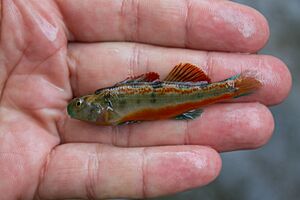Snubnose darter facts for kids
Quick facts for kids Snubnose darter |
|
|---|---|
 |
|
| Conservation status | |
| Scientific classification | |
| Synonyms | |
|
The snubnose darter (Etheostoma simoterum) is a small freshwater fish. It belongs to a group of fish called darters. Darters are part of the larger family called Percidae. This family also includes fish like perches. Snubnose darters live only in the southeastern United States.
There are two types, or subspecies, of snubnose darters. One is the Cumberland snubnose darter. The other is the Tennessee snubnose darter. These two types can sometimes breed together. Snubnose darters are usually about 45 millimeters (1.8 inches) long. A female darter lays about 152 eggs at a time. Most snubnose darters live for less than two years. They like to live in streams where the water flows over rocks. As of 2000, this fish was doing well. It is found in many places and does not need special help to survive.
Contents
Where Do Snubnose Darters Live?
Snubnose darters are found in the Tennessee River and Cumberland River areas. These rivers flow through states like Tennessee, Virginia, Kentucky, North Carolina, Georgia, and Alabama. The Tennessee snubnose darter lives in the Tennessee River system. It has also been moved to other rivers. The Cumberland snubnose darter lives in the Cumberland River system. Sometimes, the two types of darters meet and breed in the lower Tennessee River area.
What Is the Snubnose Darter's Home Like?
Snubnose darters live in streams with flowing water. They prefer areas with bedrock or gravel at the bottom. The water usually has a moderate current. They have been seen laying eggs when the water temperature is between 11 and 18 degrees Celsius (52-64 degrees Fahrenheit). These fish like places with no plants or just a little bit of algae.
Snubnose darters do not like cloudy water. They also avoid places where the stream bed is covered in mud or silt. Human activities can cause more silt in the water. For example, building dams or removing trees near rivers can harm their homes. This can threaten darter populations.
What Do Snubnose Darters Eat?
Adult and young snubnose darters eat small water bugs. They mostly eat midge larvae, which are tiny insect young. Studies show that midge larvae make up most of their diet. Depending on the darter's size, 80% to 100% of their stomachs contained midge larvae. They also eat other small creatures. These include mayfly young, caddisfly young, and tiny crustaceans.
Snubnose darters eat the most food in April. This is when they are busy laying eggs. They eat much less in very cold months like January. They also eat less in very hot months like July. This is because they are less active then.
Snubnose Darter Health Concerns
Larger darters can get internal parasites. These are tiny worms that live inside their bodies. They can also get external parasites. These include "black spot disease" and leeches.
Snubnose Darter Life Cycle and Reproduction
Snubnose darters become ready to breed when they are one year old. They usually only breed for one season. This happens in April to early May. They lay their eggs in rocky pools or cracks. They need places with very little mud or silt.
Male darters start to get bright colors in January. By April, they are deep green or blue-green. They have red fins and red spots on their bodies. Female darters do not change color much. But they might look a bit brighter during breeding season.
Their eggs are clear and have small oil droplets. They are about 1.2 millimeters (0.05 inches) wide. One study found that females can lay between 110 and 240 eggs. Males try to attract females by showing off their bright colors and fins. A female will then lead the male to a good spot to lay eggs. This is often a large stone or sometimes a gravel bed.
The male and female vibrate together. One or two eggs are released and fertilized by the male. Then, they might move to another spot to lay more eggs. Snubnose darters often mate with more than one partner. After the eggs are laid, the parents do not take care of them. Snubnose darters live for a maximum of 18 months.
How Are Snubnose Darters Protected?
The snubnose darter is listed as "currently stable." This means it is found in many places and its numbers are steady. It does not need immediate help to survive. Experts say the snubnose darter is very strong. It is not easily harmed by changes in its environment.


